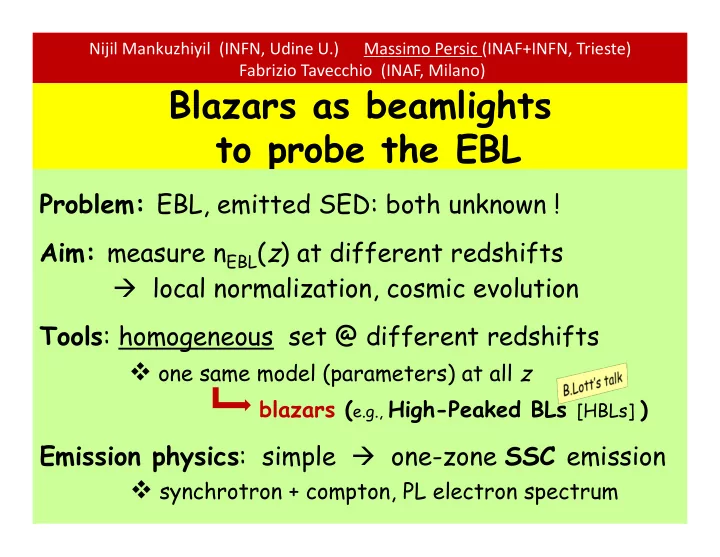

Nijil Mankuzhiyil (INFN, Udine U.) Massimo Persic (INAF+INFN, Trieste) Fabrizio Tavecchio (INAF, Milano) Blazars as beamlights to probe the EBL Problem: EBL, emitted SED: both unknown ! Aim: measure n EBL ( z ) at different redshifts local normalization, cosmic evolution Tools : homogeneous set @ different redshifts one same model (parameters) at all z blazars ( e.g., High-Peaked BLs [HBLs] ) Emission physics : simple one-zone SSC emission synchrotron + compton, PL electron spectrum
One-zone SSC: model parameters : Tavecchio + 2001 Plasma blob: R , B , δ j ApJ, 554, 725 Electron pop: n 0 , α 1 , α 2 , E br , E min , E max Kino+ 2002
The method ( 1 ) Simultaneous multi- ν obs’s : optical + X-rays + HE γ -ray + VHE γ -ray Model SED : use SED w/out (EBL-affected) VHE γ -ray data : χ 2 -minimization SSC model ( check structure of multi-D parameter space ) T T T T T simulated data T T T
…the method ( 2 ) s i m u l a t e d d a t a Extrapolate model SED into VHE regime “intrinsic” blazar VHE emission simulated data Observed vs “intrinsic” emission τ γγ γγ (E,z) Assume (concordance) cosmology n EBL ( ε , z j ) (parametric: ∑ a nj ε n ) simulated data
Checking the method … locally PKS 2155-304 Aharonian+ 2009 ApJ, 696, L150 z = 0.12 SSC param’s γ min = 1 FERMI γ br1 = 1.4 × 10 4 γ br2 = 2.3 × 10 5 Swift ATOM γ max = 3 × 10 6 HESS α 1 = 1.3 α 2 = 3.2 R XTE α 3 = 4.3 B = 0.018 G cm R = 1.5 × 10 17 δ = 32 EBL de-absorbed … caveat… … assumed electron spectrum is triple -PL …
… our effort data: Aharonian+ 2009 ApJ, 696, L150 SSC parameters from χ 2 minim. n e =150 cm - 3 ATOM γ min = 1 Swift, Fermi γ br = 2.9 × 10 4 RXTE γ max = 8 × 10 5 H.E.S.S. α 1 = 1.8 α 2 = 3.8 B = 0.056 G R = 3.87 × 10 16 cm observed δ = 29.2
�
Malkan & Stecker 1998 p r e l i m i n a r y Stecker & de Jager 1998 Stecker 1999 z =0.12
Franceschini + 2008 � 1 0 . 0 = z 3 0 0 . 0 = z z =0.12
For EBL photon energies β ( E , ε , φ ) ≡ [1 – 2( m e c 2 ) 2 / E ε (1-cos φ )] 1/2 ε > 2( m e c 2 ) 2 / E (1-cos φ ) Heitler 1960 σ ( E , ε , φ ) σ ( E , ε ) max by ( for head-on collision ) 2.5 E γ , TeV µ m ≈ Optical depth 0 ≤ z ≤ z s ε > 2( m e c 2 ) 2 / [ Ex (1+ z ) 2 ] x ≡ 1-cos φ τ (E γ , z ) = ∫ d l /d z ∫ x /2 ∫ n EBL ( ε ) σ ( 2x E ε /(1+z) 2 ) d ε d x d z Stecker 1971 cosmology n EBL ( ε n , z j ) = ∑ a n,j ε n n EBL ( ε ,z) unknown parameterize Stecker 1999
Conclusion Cons: indirect measurement of EBL method depends on blazar model Pros: unbiased method no assumptions on EBL, blazar SED SSC well tested locally on different emission states Check: on local (z=0.12) blazar PKS 2155-304 deduced τ ’s within reasonable range Aim: to probe EBL out to z ≈ 1 with Fermi /LAT + current/upcoming enhanced IACTs ( + x-ray, optical tel’s ) ( long live Fermi to see CTA / AGIS !! ) Need: simultaneous multi- ν obs’s of several blazars in shells of z possibly each source seen @ different levels of activity ( to increase statistics ) plan simultaneous obs’s involving IACTs + Fermi + X-rays + optical
Thanks
Recommend
More recommend